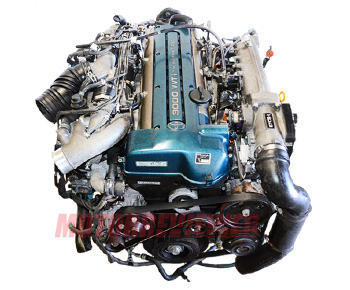Toyota 2JZ GE/GTE/FSE Engine Specs, Problems, Reliability, Info

The 2JZ engine was produced from 1991 to 2007. It is a 3.0-liter inline six-cylinder, gasoline engine, one of the most famous Toyota engines, especially by the 2JZ-GTE twin-turbo version used in the iconic Toyota Supra. But a common version is the 2GZ-GE engine - naturally aspirated power unit, widely used in Toyota's and Lexus's cars (such as Toyota Altezza, Aristo, Soarer, Lexus IS300, GS300, and SC300) and well known for the great reliability and performance.
The general architecture of the 2JZ is similar to the 1JZ, but it is not just a simple stroked version. The cylinder block is made of cast iron, strong and durable material. The 2JZ engine block is taller than 1JZ due to increased stroke by 14.5mm (0.57 in). A new crankshaft with increased stroke also required longer connecting rods (they are hot-forged). The first generation 2GZ-GE had an aluminum cylinder head with a straight forward design - four valves per cylinders, centrally located spark plugs, and belt driven double overhead camshafts. Intake valve diameter is 33.5 mm; exhaust valve diameter - 29.0 mm. Camshaft specifications: duration - 233/236 deg (intake/exhaust), valve lift 8.26/8.41 mm (intake/exhaust). The engine was equipped with a traditional ignition system with a distributor and one ignition coil. The intake includes an aluminum intake manifold and Toyota's ACIS system (variable length intake). The naturally aspirated 2JZ has 10.5:1 compression ratio.
In 1997, Toyota released the second generation in which engineers implemented VVT-i for the intake valve timing and more advanced ignition system DIS (not a true Coil-On-Plug still, but with 1 ignition coil for two cylinders). 2JZ-GE VVT-i engines got new connecting rods made of high-strength vanadium steel. Camshaft specifications for the 2JZ VVT-i: duration - 233/226 deg (intake/exhaust). VVT-i engines go with Toyota's Electronic Throttle Control System - intelligent (ETCS-i). All 2JZ versions (non-VVT-i and VVT-i as well) had shimless buckets in the valvetrain. The valve adjustment is required every 60k miles (100k km). The production of the 2GZ-GE VVT-i discontinued in 2005.
The 2JZ-GTE Engine
The twin-turbocharged 2JZ version was produced from 1991 to 2004. It was first introduced in the Toyota Aristo V (Japan) and then in the Toyota Supra (JZA80). This engine uses a 2JZ-GE engine block, crankshaft, and connecting rods. The bottom features new pistons with recessed piston tops lowering compression ratio down to 8.5:1. Engineers also added oil spray nozzles for additional cooling of the pistons. The 2JZ-GTE got a new cylinder head with reshaped intake and exhaust ports, new valves and camshafts. The 2JZ turbo engine has its own intake manifold but it kept Toyota's ACIS system. Like the 2JZ-GE in 1997, the twin-turbo 2JZ-GTE engine received Toyota's VVT-i variable valve timing technology for the intake only. Late VVT-i 2JZ-GTE engines feature weaker connecting rods than non-VVT-i engines.
Engines for Japan domestic market (JDM) and for the North American/European markets have some differences in components and, as a result, in performance. Japan models are equipped with ceramic turbochargers CT20 (with the B, R, and A part number suffixes), 440 cc injectors, and camshafts with following specs: duration - 224/233 deg (intake/exhaust), valve lift 7.8/8.25 mm (intake/exhaust). These engines produced 280 hp at 5,600 rpm and 320 lb-ft (434 Nm) of torque at 4,000 rpm in non-VVT-i version. With the introduction of VVT-i, the torque increased to 333 lb-ft (451 Nm).
Export models were equipped with stainless steel turbochargers CT12B, more productive injectors (550 cc/min), and other camshafts. USDM/EURO camshafts specs: duration - 233/233 deg (intake/exhaust), valve lift 8.25/8.25 mm (intake/exhaust). 2JZ-GTE engines for export models are more powerful: 320 hp at 5,600 rpm and 315 lb-ft (427 Nm) at 4,000 rpm for the US, and 325 hp/325 lb-ft (440 Nm) for Europe.
The 2JZ-FSE Engine
The 3.0-liter Toyota 2JZ-FSE engine was produced from 1999 to 2007. The engine features in the first place a direct injection system D4, high compression ratio 11.3:1, and it comes with VVT-i only. The engine output is similar to NA 2JZ-GE - 217 hp of power at 5,600 and 217 lb-ft (294 Nm) of torque at 3,600. The 2JZ-FSE is always offered with an automatic gearbox.
Engine Specs
Direct injection
507 lbs (230 kg) - 2JZ-GE
5.2 l (5.5 qt) - 2JZ-GE Supra
SAE 10W-30 Synthetic Motor Oil - turbo engines
Oil recommendations and capacity may vary depending on the car model, year, and market. Please check the service manual specific to your vehicle!
2JZ Engine Problems and Reliability
2JZs are famous for incredible durability. But they also have some common problems found after thousands of miles. Non-VVT-i engines are simpler and reliable than with VVT-i. But they both perform not well in a cold weather condition and sensitive to moisture. The weak point is a water pump as well as the actuator of the VVT-i system. Another common problem is the failure of one of the ignition coils which leads to misfiring in two cylinders. Turbocharged engines for Japan market have turbochargers with ceramic wheel, which prone to fall apart under high loads too soon.
The 2JZ engine can reach a 300k mileage mark easily with proper maintenance and quality engine oil, filters. It also offers a great opportunity for tuning, showing outstanding power outputs for a small number of upgrades and modifications.
